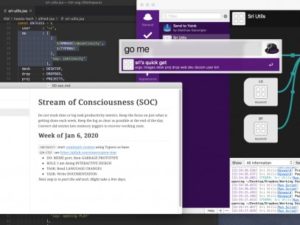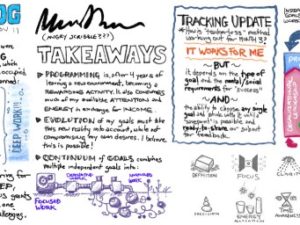(last edited on January 9, 2021 at 10:00 pm)
Time for yet another progress report on maintaining my new year’s self-improvement goals, what I call Groundhog Day Resolutions (GHDRs) because I make them on February 2nd after I’ve recovered from the holiday season. I just realized that I like the name also because there is an theme of procrastination subtly underscoring my approach: Groundhogs like to sleep (as do I), I’m kind of a “low energy” person when it comes to starting projects, but I want everything I do to be awesome. Low energy and high standards usually results in procrastination instead of excellence, but GHDR has the potential to work with me rather than change me.
Motion Generates Energy
I’m really not a go-getter by nature, so the GHDR “system” is really designed to address that: it’s a lazy approach, not a high-energy one. That’s why a lot of New Year’s Resolutions fail for people: the investment of initial energy is exciting and very high, but maintaining that sustained burn rate is all but impossible for all but the most energetic and focused of us. Those are the people who become natural coaches and productivity gurus, but sadly that is not me. I would go so far to say that the demographic I fall in is that of the low energy, passionate creative. I love the feeling of getting something done, but it’s easy for me to get derailed by distractions. I am also very good at estimating the amount of work required to get anything done to completion, which tends to diminish my enthusiasm to start because I am also very impatient. It doesn’t help that I’m good at seeing holes in tools, workflow, and knowledge; while this is a great skill to have when optimizing existing processes, it’s a huge bummer when it’s time to create a new system from scratch all by yourself. The massive weight of the endeavor is tangible, and my energy slumps in response. Result: nothing gets done.
My process for overcoming my low energy state pretty simple: I just try to start moving and not think too much about the consequences. I just did it with this blog post, which I’ve been putting off for a day because I wasn’t sure what to write. I started by looking at what I wrote last time (always a useful crutch) and just started riffing off of that. Everything I’ve written so far has been pure “stream of consciousness”, which I find pretty easy. Now that I’m moving, I have a sense of where this post is going and can start filling in the gaps. This is where that ability to see holes in various things becomes an appropriate supporting skill as opposed to using it as a creative one. Being creative is an entirely different skill altogether, and it has just hit me that creativity and productivity go hand-in-hand. Add motion to the mix, and you have a recipe for kicking ass. Then add focus or direction, and you have the means to really get things done.
But I am starting to digress. What I’m trying to say is that I’m passionate yet low-energy, and therefore need to focus just on motion. Any motion at all, like just spending 10 seconds writing a sentence. That’s what the Groundhog Day Resolutions system, which was born out of the recognition that I’m just too damn tired on January 1st to make any goals, is more suitable to me. The GHDR System is designed to maintain momentum via natural levels of desire, whereas other systems seem to be designed to use either pressure (nagging) or structure (idealize process) to create the necessary motion. I happen to know that what works for me is just focusing on moving, and I will build structure as necessary, so it’s no surprise that GHDR has evolved the way it has. I suspect what I’m describing is a subtle-enough difference that a lot of people might not “get it”; even I am wondering if I’m just imagining that it’s there. However, this insight fits general principles I use when analyzing workflow:
- determine the valued result or benefit from each process…in this case, I want to be making progress toward some personal goals that will leave me more fulfilled as a person with more financial resources for minimum effort.
- determine what resources are used by each process…which for me is time, energy, and to some extent knowledge.
- determine sources of drag or suckiness…which not surprisingly is low-energy due to the procrastination factors I mentioned above.
- identify natural reservoirs of strength that can be repurposed…which for me is knowing that once I’m moving,
- make sure to optimize for root causal forces, not symptoms…and in this context the root causal force is just to maintain motion, which means to generate energy or make better use of what is available. Nagging and idealized processes are examples of treating symptoms, which brings limited or short-lived success.
Goals Reviewed
One difference between Groundhog Day Resolutions 2008 and the original trial run has been the addition of a summer break that runs from June 6 through July 7, when a goal reassessment is scheduled. I know I’m probably going to hit a slump around now due to the nice weather, and there’s no sense in beating myself up about it. As important as these goals are to me, they are also longer-term goals that compete with important short-term ones. I can’t make everything a high priority goal, so I focus on work, people, and health right now and assign whatever energy remains to GHDRs. Summer is that time here in New England where you get outside in what we call “sun” and play with other people. I’m taking that into account and reducing the pressure. After this mini break, it makes sense to look at one’s goals and see if they still make sense. Time away brings new perspectives.
This is on my mind right now, actually, so I’m going to compare the goals from February 2nd…
- Commit to Deriving Income from Writing and Making Stuff
- Build Sustainable Social Networks
- Sell a Product
…to the goals of May 5th:
- Figuring out how to be a full-time writer and content creator, because I like it.
- Reduce my needs. If I can live cheaper, then I need less money, and can work less.
- Work based on my vocation, so it’s work that sustains me in spirit, mind and body.
I also had scheduled two reflection days, to help maintain motion. Rather than assign a task, I thought it would be just as good to just think about what I’m doing and why it’s important. It sounds like a cop-out, I know, but I ended up itemizing my priorities into several lists. Looking back at them now, I can see that I was just feeling a certain ennui with the way life was going. Getting some of those lingering burdens out of the way, one-by-one, seemed to unstick things. It didn’t take as much dramatic action as I thought. I didn’t even take the second reflection day, because I am actually feeling on-track.
As for actual review:
Figuring out a living as a full-time content creator is going to be on the backburner for the next several months as I finish some long-term projects, but in the meantime I am pondering what I can offer in terms of content creation. And I’ve come to realize that content creation can go beyond media and extend into consulting and relationship making. For example, part of my design process is to interview people for about an hour about their project context and motivations. I have heard over and over that this often a powerful experience, to sit with someone who listens well and can synthesize insight seemingly at will. If I frame this in the right context, it becomes an interesting service offering, one that I would actually really enjoy. This would then fulfill the work based on my vocation goal. As for reducing my needs, I at least have declared Wednesday from 10AM to 11AM as my Financial Review Hour. Knowing what I’m spending for what is the first step. A larger contextual goal is to get my shit together and clean up my house, put some more domestic processes in place, and make living pleasantly low-maintenance.
Looking back on the earlier goals:
I’ve actually reached a point where my local social networks are self-sustaining. Or rather I should say that I’m starting to know enough people with similar age and interest that I’m not feeling socially isolated anymore. Likewise selling a product is ongoing; I’m selling the remaining stock of pre-printed Emergent Task Planning Pads (still have quite a few to sell, so I’ll probably post the direct store link soon). The intent behind selling a product is to support my real goal of making money by being a content creator.
I find it slightly surprising that progress was made without deliberately scheduled anything. You’d think that without planning and scheduling, nothing would have happened. Perhaps it works because I’ve aligned two forces together: my real desires and periodic reflection. This was enough to get me to do something when I had a moment or I when I was talking with friends. By knowing my real desires and reflecting on them, I may have structured my mental outlook in such a way that progress became more opportunistic and spontaneous. This is an interesting idea, more artistic than by design.
Wrapping Up
Thus begins the month-long holiday from goals. We’ll resume our goal trekking on Tanabata, the Japanese “Star Festival” when you write down your wishes on streamers and hang them on trees so they might be granted by gods that live in the sky.





5 Comments
Great post, David. I always love the insight into your planning and reflections.
I, too, am beginning to plan for motion, not for projects. I think the reason it works more is because I am spending more time creating stuff that I actually want to do, rather than stuff I don’t want to do. The productivity systems that we know and love tend to help us do things we don’t want to do.
Something interesting hit me while reading. You say: “I happen to know that what works for me is just focusing on moving, and I will build structure as necessary, so it’s no surprise that GHDR has evolved the way it has.”
Weird parrallel, but I’m currently teaching myself Ruby on Rails, and there’s a process in building with RoR called scaffolding. The basic idea, as I currently understand it, is to very quickly get the structure of the design you want now and very quickly remove it when you deploy the app. As such, you aren’t bogged down by complicated problems – you’re actively moving towards the completed project.
I think I’ll write more about this on my blog, so you may see a link inbound. The idea of a productivity system that structures the movement towards a goal rather than directs the movement towards a goal is a paradigm shift worth pursuing.
I’ve also thought of offering my services as a project and time management consultant up for hire. It’s something I love doing, and other people have commented on how helpful the process is for them. But I see what it would take to make that happen, and right now I couldn’t commit myself fully enough to make it something successful rather than another great idea that I’ve started but can’t finish.
Thanks for the inspiration, David.
David~
I really enjoyed your post, but noticed something that about your goals that might not help you achieve optimal results: I don’t think your goals are explicit and measurable enough.
For instance, “Reduce my needs. If I can live cheaper, then I need less money, and can work less” is right on. (i’m working on that one myself) But, it’s hard for humans to be objective when we evaluate our goals. Because it’s inexact, it will be harder to know how much you really improve.
Your goal might be improved from a benchmarking standpoint if add some measurability and exactness to it. So, something like: “I want to reduce my needs (monetarily) by 15%.”
Then you have the ability (as long as you have some way of watching your finances) to watch how well you’re doing, and continually benchmark yourself to see how you improve.
Justin: Yes, I agree. It’s a lot easier to measure progress against specifics, and usually I am much more explicit about this kind of thing when I’m working.
I think I’m reaching for something different in my GHDRs, which is NOT to have specific measurable targets. While this might sound insane, it’s how I’m feeling about resolutions in general. I basically want to artistically approach goals and see what happens along the way.
Your insight, however, is very appropriate for any real-world goal setting, and I’m glad you mentioned it here. It’s helped me realize that what I’m doing probably shouldn’t be called goals at all here, but something else.
makes sense. thanks for the explanation.
Sounds like the early summer is a time to focus on different goals: “Get outside in what we call ‘sun’ and play with other people.” Or maybe it’s a different way of meeting the goals of people and health. Or, maybe it works better as an all around break and chance to do things which aren’t obviously goal-related—a chance for serendipity to do its thing.
As for living cheaper, I found recording each and every cent helps a lot. Some irregular, small expenses were actually regular and added up to a lot.